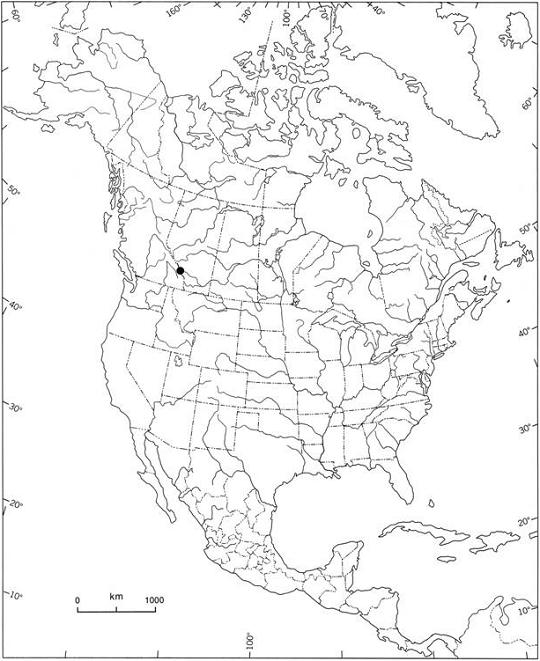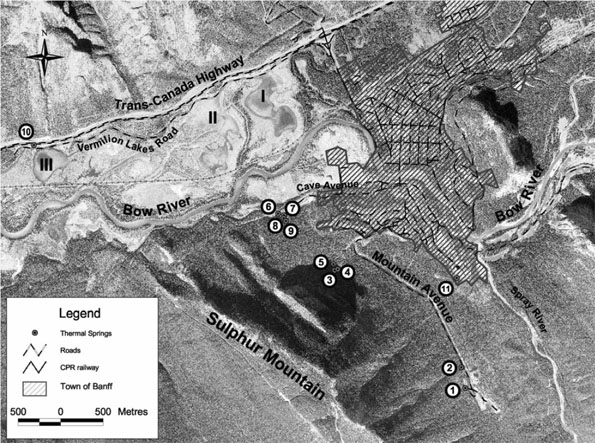Banff Springs snail (Physella johnsoni) COSEWIC assessment and status report: chapter 6
Distribution
Global and Canadian Range
Physella johnsoni is endemic and restricted to a few thermal springs. All these springs occur within the southern Canadian Rocky Mountains immediately adjacent to the Town of Banff within Banff National Park (BNP), Alberta (Figures 4 and 5). Burch (1989) includes Alberta, Montana, Wyoming, and Colorado in the species’ distribution, most likely from museum specimens, but is erroneous. Others also do not list P. johnsoni as occurring in Montana (NatureServe 2006), Colorado (Wu 1989), or Wyoming (Wu and Beetle 1995). All historic and current subpopulations occur in Canada.
The type specimens were collected from “middle spring, Hot Sulphur Springs, Banff, Alberta” (Clench 1926) (Figure 5). A second lot consisting of bleached shells only was “collected by E.C. Case in a deposit below the swimming basin” (Clench 1926). Clarke (1973) lists the species as having been collected from “Upper Hot Springs, Banff, Alta. (1927, T. Ulke). Middle Spring, Hot Sulphur Springs, Banff, Alta. (type lot)” and “Kidney Spring, Hot Sulphur Springs; Cave and Basin; and Cold Spring, Vermilion Lake, Banff (all Jan. 1927 and Jan. 1929, O. Bryant).” As there are a number of individual springs in “Middle Springs” and at the “Cave and Basin” (Figure 5), it is uncertain which specific springs were inhabited by the snail. Furthermore, Bryant’s 1927 and 1929 dates of collection are likely erroneous as specimens were received at the Museum of Comparative Zoology, Harvard University (Cambridge, MA) by Clench in August 1926 and therefore must have been collected prior to 1926 (Baldinger pers. comm. 2001; Clarke pers. comm. 2001).
Figure 4: Global distribution of the Banff Springs Snail, Physella johnsoni

The point indicates Banff National Park, Alberta, Canada.
Figure 5: Historic distribution of Physella johnsoni, the Banff Springs Snail, in thermal springs near the Town of Banff, Banff National Park, Alberta

1 is the Upper Hot Spring (snail extirpated); 2 is the Kidney Spring (snail re-introduced November 2003); 3, 4, and 5 are the Gord’s (snail extirpated), Upper Middle (snail re-introduced November 2002), and Lower Middle (snail extant) Springs; 6, 7, 8, and 9 are the Basin, Cave, Lower C&B and Upper C&B (snail extant in all) Springs of the Cave and Basin National Historic Site; 10 is the Vermilion Cool Springs (currently occupied by Physella gyrina); 11 is the Banff Springs Hotel Site (most likely from piped water, currently site no longer exists); I, II, and III are the Vermilion Lakes. Reproduced with permission from Lepitzki and Pacas (2007).
Since the original collections, the species has been collected twice: in an “Outlet of Middle Spring, 0.8 mi E of Middle Spring (i.e. 300 yds S of Banff Springs Hotel)” by H.D. Athearn, on 23 July 1965 (Clarke 1973) and from “Middle Springs” on 1 October 1975 (Iredale pers. comm. 1975). To Clarke’s knowledge the site description of the outlet stream is accurate (Clarke pers. comm. 1996); Athearn has confirmed the site (Athearn pers. comm. 1996). As no other springs were examined in 1965 (Athearn pers. comm. 1996), it is uncertain how many of the original sites continued to persist during Athearn’s collecting trip.
By 1996, the species still inhabited five of the historic sites at two locations: Lower Middle and the four springs at the Cave and Basin National Historic Site (C&BNHS) – Cave, Basin, Upper C&B, and Lower C&B (Lepitzki 1997a,b). All of these individually separate thermal springs are regarded as representing a single population, although snail movement between thermal springs is extremely unlikely and would require movement across dry land unless the snails are transported by birds or anthropogenically, e.g., through pipes or in containers (see Dispersal/migration). The outflow stream near the Banff Springs Hotel no longer exists and is currently under a parking lot. It is also suspected that this site resulted from thermal spring water piped from Kidney Spring to the Banff Springs Hotel (Lepitzki pers. obs.; Van Everdingen 1972), and not from the Middle Springs as the latter outflow stream is north of the hotel.
Numerous shells of P. johnsoni are found along the outflow stream of the Upper Middle Springs (Figure 5) (Lepitzki pers. obs.) suggesting that the species was recently present prior to 1996. Fewer than 10 physid shells, most likely P. johnsoni, have been found by Lepitzki in Gord’s Spring, a previously undescribed thermal spring in Middle Springs area (Figure 5). Fewer than 10 shells also have been found at Kidney Spring and fewer than five shells have been found embedded in tufa at the Upper Hot Spring within the last 10 years, suggesting that these subpopulations may have been extirpated some time ago. It is also uncertain whether live snails or empty shells were collected at the Upper Hot in the 1920s. Live physids are presently found at the Cool Springs at Third Vermilion Lake (Figure 5), but they arePhysella gyrina (Lepitzki 1997a,b; Hebert 1997; Remigioet al. 2001). It is questionable whether P. johnsoni ever existed at the Cool Springs, given the current occupancy by P. gyrina and the differences in water physicochemistry between the Cool Springs and those springs currently containing P. johnsoni (see Habitat Requirements).
It is extremely unlikely that unknown localities of the snail exist, given human fascination with thermal springs and human history and extensive use of BNP. All known thermal springs along the Sulphur Mountain thrust fault (Grasby and Hutcheon 2001; Grasby and Lepitzki 2002), the point of origin for the Sulphur Mountain thermal springs (Figure 5), including Forty Mile Spring (between Mounts Brewster and Norquay to the north) and six previously undescribed cooler thermal springs in the Middle Springs area (Lepitzki unpubl. data) have been examined for snails (Lepitzki pers. obs.). Lepitzki (unpubl. data) has also examined Miette Hot Springs in Jasper National Park (Grasby et al. 2000) and others have examined Mist Mountain Spring (Grasby et al. 2000) and no snails were found (Lepitzki unpubl. data; Grasby pers. comm. 2001).
The extent of occurrence (EO) has been calculated using Oziexplorer GPS Mapping Software (D & L Software Pty Ltd Australia 2002) on GPS points recorded with a hand-held GPS receiver (±10 m) (Figure 5). If all historic sites are included in the polygon (COSEWIC O&P Manual 2006) except the Banff Springs Hotel site and Vermilion Cool Springs, an EO of 345 409 sq. m. (=0.345 km2) results. As of 1996, the EO had declined to 32 579 m2 (=0.0326 km2) with extant subpopulations being found at only five springs. As of 2006, two subpopulations have been re-introduced and are self-maintaining (Upper Middle and Kidney, see Population Sizes and Trends), and the EO increased to 176 755 sq. m. (=0.177 km2). If the snail is ever re-introduced at the Upper Hot and Gord’s Springs (Lepitzki and Pacas 2007), the EO would revert to historic levels.
Not only does P. johnsoni have a severely restricted distribution, as shown by the small EO, it also has a marked microdistribution within each spring (Lepitzki 2002a) (see next section). Area of Occupancy (AO) was calculated to be 5 km2 using a 1 × 1 km grid and including the two re-introduced subpopulations (A. Filion, April 2008). The actual, more biologically defensible AO was calculated to be 595.4 m2. (=0.0006 km2) (Table 1). The area between the blue line and the nearest end boards of a North American ice hockey rink (595.25 m2, Wikipedia 2006) is similar. This occupied habitat is the Critical Habitat for the snail (Lepitzki and Pacas 2007).
| Spring | Area of occupancy (sq. m.) |
10+ year population minimum |
10+ year population maximum |
|---|---|---|---|
| Kidney | 25.6 | 8 | 8 852 |
| Upper Middle | 176.2 | 16 | 16 247 |
| Lower Middle | 22.4 | 30 | 4 221 |
| Cave | 190.4 | 474 | 5 657 |
| Basin | 80.5 | 162 | 10 242 |
| Upper C&B | 31.3 | 147 | 3 268 |
| Lower C&B | 69.0 | 43 | 4 619 |
| Original 5 combined | 393.6 | 1 561 | 16 427 |
| Original 5 + 2 re-introduced | 595.4 | 1 561 | 33 915 |
Upper Middle and Kidney Spring subpopulations were re-introduced in November 2002 and 2003, respectively. The Basin population includes the fall 2005 augmented Basin outflow stream snails.